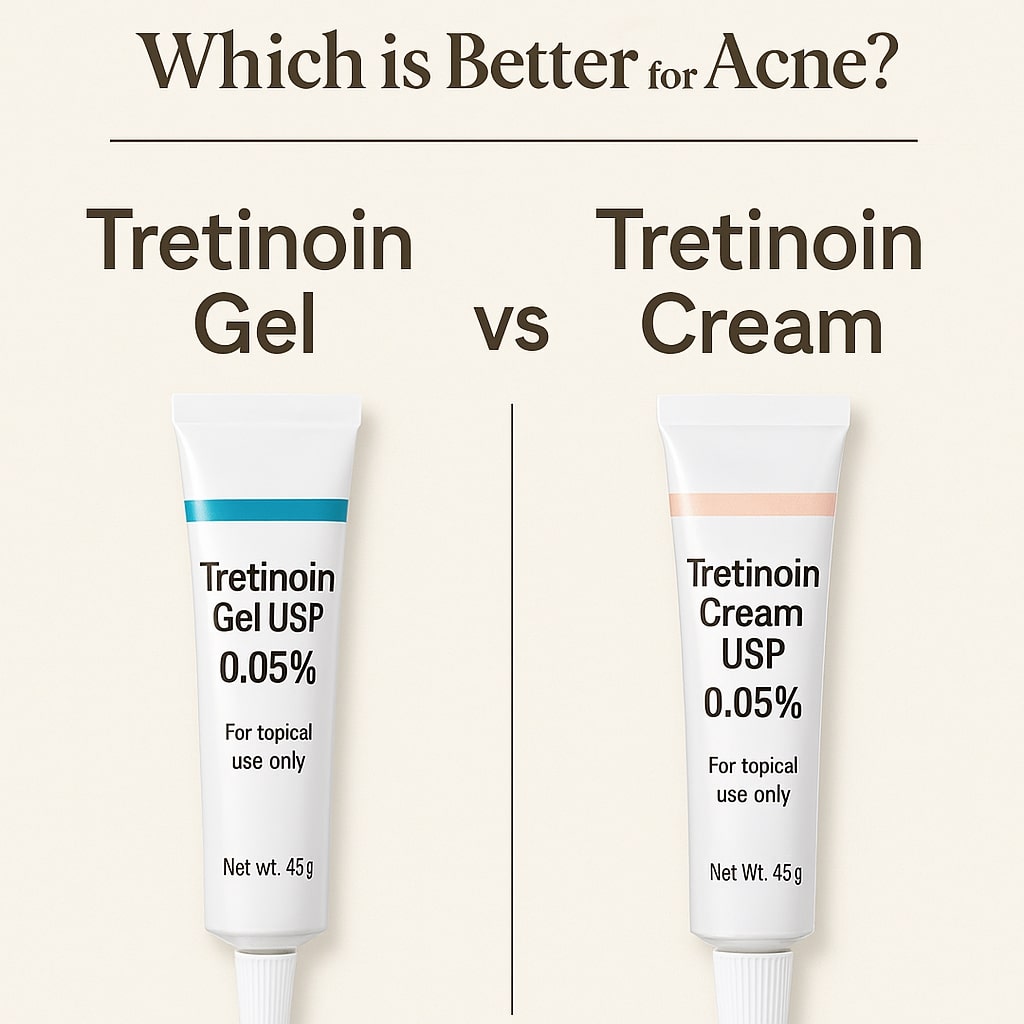When it comes to treating acne, Tretinoin has long stood as a gold-standard topical treatment. But within this category, there’s a common question: Should you use Tretinoin gel or cream? Both formulations contain the same active ingredient — a derivative of vitamin A — yet they can work differently depending on your skin type, acne severity, and individual response. In this blog, we’ll explore the differences between Tretinoin gel and cream, their benefits, drawbacks, and help you decide which one might be better suited for your skincare journey.
🔍 What Is Tretinoin?
Tretinoin (also known as all-trans retinoic acid) is a prescription-strength retinoid used primarily to treat acne, reduce fine lines, and improve skin texture. It works by:
- Increasing cell turnover
- Preventing the clogging of pores
- Reducing inflammation
- Stimulating collagen production
You’ll find Tretinoin available in different strengths (0.01%, 0.025%, 0.05%, 0.1%) and formulations — mainly gel and cream.
🧴 Tretinoin Cream: A Closer Look
✅ Pros:
- More moisturising: Contains emollients, making it suitable for dry, sensitive, or mature skin.
- Less irritating: The cream formulation tends to release the active ingredient more slowly, reducing the chance of redness, peeling, and dryness.
- Better for full-face application: If you’re using Tretinoin to target both acne and signs of ageing, the cream is generally more tolerable.
❌ Cons:
- May clog pores: The thicker consistency can be a downside for oily or acne-prone skin.
- Slower absorption: It may take longer to see results, especially if you’re treating severe acne or very oily skin.
💧 Tretinoin Gel: A Closer Look
✅ Pros:
- Lightweight and oil-free: Ideal for oily, acne-prone, or combination skin.
- Faster absorption: Penetrates the skin more rapidly, delivering quicker results for active breakouts.
- Less risk of clogged pores: Because it’s non-comedogenic and doesn’t contain heavy moisturisers.
❌ Cons:
- More drying and irritating: Tends to be harsher, especially for those with dry or sensitive skin.
- Not ideal for ageing or sensitive skin types: Might cause more redness or flaking.
🔄 Comparison Table: Tretinoin Gel vs Cream
| Feature | Tretinoin Cream | Tretinoin Gel |
| Skin Type | Dry, sensitive, mature skin | Oily, acne-prone skin |
| Consistency | Thick, creamy | Lightweight, watery |
| Absorption | Slower | Faster |
| Irritation Level | Low to moderate | Moderate to high |
| Moisturizing Properties | Yes | No |
| Clogging Pores Risk | Higher | Low |
| Best for Anti-aging | Yes | Less suitable |
| Acne Severity Suitability | Mild to moderate | Moderate to severe |
🧬 Which Form Works Faster for Acne?
Tretinoin gel is often considered to work faster, especially for active breakouts, due to better skin penetration. However, its potency can also lead to increased irritation, which might slow progress if you have to reduce the frequency of use.
Tretinoin cream, on the other hand, may offer steadier, gentler improvement over time, which can be beneficial for long-term maintenance and users who are prone to irritation.
💡 How to Choose Between Gel and Cream?
Consider the following factors:
1. Your Skin Type
- Dry/Sensitive Skin → Cream
- Oily/Combination Skin → Gel
2. Your Goals
- Targeting acne only? → Gel for faster results
- Also addressing fine lines & texture? → Cream offers dual benefits
3. Your Tolerance Level
- If you’re a beginner, start with a low-strength cream to build tolerance.
- Experienced users with resilient skin may prefer the gel for its efficacy.
🛠️ Tips for Using Tretinoin (Cream or Gel)
Whether you go with the cream or gel, follow these tips to minimise irritation and maximise results:
- Start slowly: Apply 2–3 times a week at night, then increase frequency gradually.
- Use a pea-sized amount: More is not better. Overuse increases irritation.
- Wait after washing: Allow skin to dry fully (about 20 minutes) before applying.
- Moisturise: Always apply a gentle, non-comedogenic moisturiser afterwards.
- Wear sunscreen: Tretinoin increases sun sensitivity; SPF 30+ is a must.
- Avoid harsh products: Don’t use with other exfoliants, astringents, or alcohol-based toners.
🤔 Can You Switch Between Gel and Cream?
Yes, and in some cases, your dermatologist may recommend switching based on how your skin responds. For example, if gel causes too much dryness, switching to cream may help you stick to your treatment plan more comfortably.
🔬 What Do Dermatologists Say?
Most dermatologists agree that both gel and cream forms of Tretinoin are effective for acne. The key is consistency and choosing a formulation your skin can tolerate.
Dr. Sandra Lee (aka Dr. Pimple Popper) explains:
“The best Tretinoin is the one you can actually use long-term. It’s not about how strong it is — it’s about sticking with it.”
🧾 Final Verdict: Which Is Better for Acne?
There is no one-size-fits-all answer. Here’s a quick summary:
- Use Tretinoin Gel if:
➤ You have oily or acne-prone skin
➤ You want faster acne results
➤ You can tolerate more dryness - Use Tretinoin Cream if:
➤ You have dry, sensitive, or ageing skin
➤ You need a gentler approach
➤ You’re treating both acne and wrinkles
Ultimately, your dermatologist’s guidance is invaluable. They can tailor the right formulation and strength for your skin type and goals.
💬 Ready to Choose?
Whether you opt for gel or cream, remember that Tretinoin takes time — usually 8 to 12 weeks to start showing real results. Be patient, stay consistent, and give your skin the care it deserves.
Shop dermatologist-trusted Tretinoin formulations at PremiumRxDrugs and begin your journey toward clearer, smoother skin today.
Marie
Latest posts by Marie (see all)
- What is an Antifungal Cream and How Does it Work? - December 19, 2025
- Life with Asthma: How the Right Inhaler Medicine can Change Everything? - December 15, 2025
- Desowen Cream 0.05% for Itching & Rashes: Complete Treatment Guide - December 13, 2025




